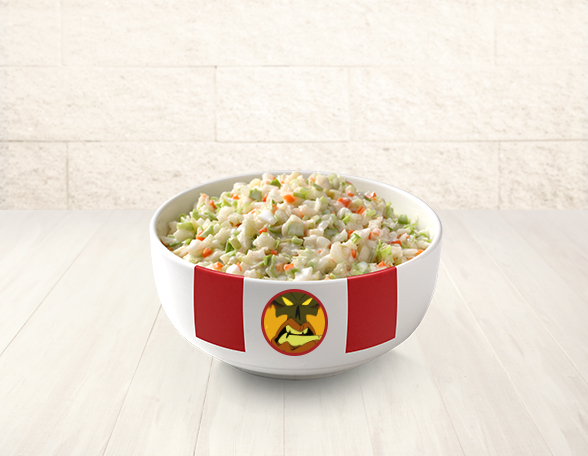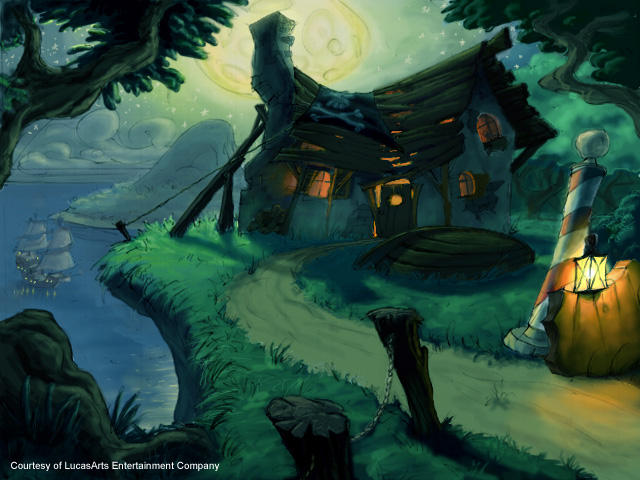Articles

Jonathan Ackley and Larry Ahern look back on 25 years of CMI Page Two
Bill Tiller once shared an early background painting that seemed to depict the Barbery Coast and Danjer Cove as being on Blood Island rather than Plunder Island, as they are in the final game. Any recollection of this change and/or the design reshuffle that prompted it?

Jonathan: That piece of art was never meant for the final game, so there was no change in the design. Bill was just trying out artistic elements to see if he could get Larry and I excited. When we saw that one, we knew he’d nailed the art style.
Larry: Surprisingly, I have no corrections or additional comments for this answer. Jonathan has accurately and eloquently answered the question. And for once I’m going to see if I can keep my answer as short or shorter than his instead of rambling… too late.
I think you guys did a good job of avoiding the trap of reprising too many ancillary characters from the past, in order to make room for new characters. Aside from the “main cast” (Guybrush, Elaine, LeChuck, and the Voodoo Lady) we ultimately get reappearances from Wally, Stan and Lemonhead. Were any other cameos considered?
Larry: Supporting characters are usually designed around scenarios or specific puzzles that you want to include, so you really have to plan ahead to try and make a particular character fit. We wanted to give the audience some closure on Stan and Wally (whose fates are unclear at the end of Monkey 2), so that was a no brainer. And then I think we just had a funny idea for the cannibals.
Jonathan: I’m sure we considered them all at one time or other, but the characters had to fit the puzzles and the story, so not all were going to fit.
I remember at the time thinking that the arcade sequences in Curse were way more successful than the similar attempts made in Full Throttle (whose engine it largely inherited), perhaps due to their mouse-driven simplicity. Any memories of lessons learned, or of what limitations you had to consider when trying to design and implement “action” scenes using SCUMM?
Jonathan: The game design note was, “Just make it fun.” One of our programmers, Chris Purvis, got the assignment. We based it on an old Atari/Apple/Commodore game called Broadsides. We knew that many adventure game fans objected to action sequences, so we added ‘easy’ mode which wasn’t so much a game as an activity.
SCUMM isn’t really that limited a development platform, although it is optimized for adventure games. Making an action game fun is really in the programming. While working on Full Throttle, I was asked to do a little programming on the Crush-up-Derby. The controls weren’t to my taste, so I went in and changed them. I did this for both the cursor and keyboard controls. The original implementer found my mouse code changes and reverted them, but he missed the keyboard controls. I have a strong feeling that most people wound up solving the sequence with the keyboard.
Larry: I just remember the suggestion that we add these and being terrified after the less than stellar results from Full Throttle. Then I got busy with other stuff and later someone said, “Hey, check out this cool ship combat game!” And it was already done and a lot of fun, so what could I say? The lesson: give talented people enough freedom to do amazing stuff when you’re not looking. That and also: hire talented people (easier said than done. LucasArts just attracted them like flies in the ‘90s).
Curse established a pattern I find interesting. The game modified the Full Throttle engine to restore the sentence line and inventory combination (both eliminations being, I think, part of Tim’s agenda to streamline the experience). Then, Escape from Monkey Island made the very same customizations to the Grim Fandango engine. Yet again, for Tales of Monkey Island, Telltale Games made a one-time concession in supporting inventory combination, which their previous games deliberately dispensed with. Do you think there’s something about Monkey Island that makes the designers gravitate slightly toward old traditions even while trying to push the presentation forward?
Jonathan: Well, it’s a Monkey Island game. People expecting Monkey Island expect to have puzzles similar to those from the previous games.
Full Throttle had a totally different feel. Throttle’s puzzles matched the main character. Ben wasn’t going to make a disguise by putting cat hair on masking tape. He was going to hit something with a lead pipe.
It is best for a game when interface, story and puzzles all have to harmonize.
Larry: Yes, I don’t think it would have felt like Monkey Island if you couldn’t combine inventory objects. And the sentence line added clarity and additional opportunities for humor. Speaking of, I now wish we’d given Ben a cat mustache. Maybe he’ll have one in the long delayed sequel: After years on the road, Ben parks his bike and opens a small bookshop, whiling away the afternoons reading to his tabby cat, Mo. But when he gets a call to host a book signing by bestselling business author Phinneas Ripburger (Adrian Ripburger’s grandson), his world is thrown upside down.
The Curse of Monkey Island ended up being the final game developed using the SCUMM engine, and was I think the only natively Windows SCUMM game. Curse was pretty envelope pushing, so I’m curious what kind of effort - which I presume Aric Wilmunder was at the head of - went into tricking it out even further.
Jonathan: Aric did give us a number of engine improvements. We also got improvements from Gary Brubaker and Vince Lee’s iNsane video system.
Larry: While Jonathan did try his hand at some art (again, Bear-Pig), thankfully I was wise enough to steer clear of any programming tasks.
While ten years is an impressive run for any engine, what are your feelings about SCUMM being put to pasture after Curse? Do you see it as a matter of necessity, or might it have continued to evolve to keep abreast of an ever-rising bar?
Jonathan: It might’ve had a game or two left in it, but the jig was up. Proscenium arch adventure games were a product of the technology of their times. I had an ‘A-Ha’ moment when I saw Half Life. I saw it and thought, “Well…that’s kinda it for adventure games as a mainstream, AAA genre.”
For the original game, Ron Gilbert had Tim Schafer and Dave Grossman to split the workload of scripting and dialog. It sounds like Chuck Jordan and Chris Purvis served a similar role for you guys on Curse. Can you give a sense of their contribution?
Jonathan: The LucasArts way was to hire programmers who could write. We knew Chris Purvis was a smart, funny guy, so we brought him up from the testing group. Chuck Jordan applied and we gave him a quick SCUMM-U. I gave him the Office Room from Sam & Max Hit the Road. I told him to do something funny with every object in the room. We came back later and saw that his stuff was hysterical. I shoulda saved his project for posterity.
Larry: It’s such a unique job description that I’m surprised we were able to find so many capable candidates. Again, LucasArts attracted the talent, thankfully. Chris was already at the company, so people knew him and thought he’d be a solid addition to the team. And Chuck was a newcomer, but we had seen some of his cartoon/writing work online and thought he had the chops, and of course he blew everyone away with his scripting/writing test.
I want to compliment you guys for making the only Monkey Island game to date that does not feature a maze. I don’t think anybody who’s had a hand in designing a Monkey Island game ever deliberately set out to make a genuinely “time-wasting” segment (the base standard of the series is a bit higher than that), but it does feel like you guys had the budget to completely avoid anything that might remotely qualify as padding. Do you remember paring any aspect of the design on the basis that it didn’t move the game forward?
Larry: I’m pretty sure now that alligator game you asked about before was a maze puzzle. You had to lure the alligators to a specific location in order to walk across their backs like stepping stones to get from Plunder to Blood Island. While wearing a cat mustache. I hate maze puzzles, but I do like alligators, so it was a hard one to cut.
Jonathan: I don’t think we consciously excluded maze puzzles. I just don’t think they were our favorite type of puzzle from the previous games.
Tim Schafer has noted that a ship-to-ship combat sequence he imagined for The Secret of Monkey Island had to be scrapped for time or space reasons. Was the appearance of the ship combat section in Curse a conscious resurrection of that idea or just coincidence?
Jonathan: When you sit down to design a pirate game, there are only so many tropes from the genre to pull from. Ship to ship combat just happens to be one of those. Now, of course, we totally stole insult sword fighting. But we made the insults rhyme, just to prove we were still working hard.
Larry: All the stuff you liked Jonathan and I came up with. The things you didn’t like were probably stolen from Tim. Or he made us put them in.
Whose idea was it to bring back insult sword-fighting, which LeChuck’s Revenge opted not to (though I always saw the “woo Elaine back” dialog puzzle as a sneaky sort of a reversed, one-sided reincarnation of that mechanic)?
Larry: That was the toughest one. We tried so hard not to make Curse feel like a retread of the previous games, but that one puzzle was so classic and we thought if we could include it with a twist, it would be worth it. I’m not sure the rhyming part was enough, but it was funny, and the flavor felt a little different interspersed with the ship combat so it was worth a shot.
Jonathan: We both thought it was Monkey Island’s signature puzzle, so we wanted to bring it back.
Curse is the only installment yet to reprise a noteworthy feature from LeChuck’s Revenge: the option of “lite” versus regular modes. While an impressive feature, I have to assume it was a ton of work to prepare two versions of the game. Did they have to be designed in tandem, or was it a case of making the full-bodied game first and then figuring out how to pull back the difficulty?
Jonathan: Actually it was super easy. Barely an inconvenience. Someone suggested it pretty late in development. I asked Chris Purvis to look at it and see how hard it would be to add. It took him about 2 days to add it in.
Larry: Again, I thought it was a horribly complicated and dangerous undertaking and would have advised against it. Then I got distracted with something else and came back and Chris had finished it. After that, I probably should have just gone on vacation and let him finish the whole game.